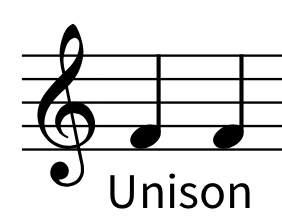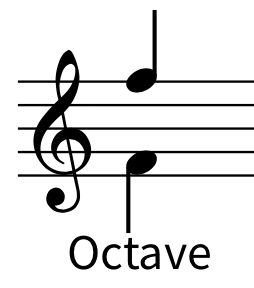2.5 Interval Size and Quality
7 min read•january 13, 2023
Mickey Hansen
AP Music Theory 🎶
72 resourcesSee Units
An interval in music refers to the distance in pitch between two notes. Intervals can also be classified as being either harmonic or melodic. Harmonic intervals are those that are played simultaneously, while melodic intervals are played one after the other. In music theory, the study of intervals is an important part of understanding how music works and how to create melodies, chords, and harmonies.
Naming Intervals
Intervals can also be described in terms of their quality, which refers to the type of interval (major, minor, etc.) and their size, which refers to the number of pitch classes they span. For example, a "perfect fifth" is a perfect interval that spans seven pitch classes. The number (2nd, 3rd, 4th,...7th) comes from the space between the letters. For example, a C to E is a 3rd, an E to G is a 3rd, etc. Intervals are usually considered as spaces less than an octave, although sometimes, you will hear people talking about a 9th or a 10th. Intervals with a size of more than an octave are called compound intervals, and you might say “three octaves” to refer to a 22nd. You usually won't hear people talking about a 22nd.
There are several types of intervals, including major intervals, minor intervals, diminished intervals, augmented intervals, and perfect intervals.
An easy way to remember whether an interval is minor, major, perfect, etc. is to think about a major scale. A major scale has all major intervals, (e.g. M2, M3, M6, etc.) except for the 4th, 5th, and the octave, which are considered perfect intervals. For example, a C to an E is considered a major 3rd, but a C to a G is a perfect 5th. You usually don't say "perfect octave" or "perfect 8th" -- just "octave" is good enough.
Once you know the major intervals, a minor interval is one half step less than a major interval. So, if C to E is a major 3rd, then C to Eb is a minor 3rd. These don't necessarily correspond to the minor scale. C to Db is a minor 2nd, but C#/Db is not in the c minor sale. You cannot turn perfect intervals into minor intervals. For example, you will not have a minor 5th or a minor 8th.
Augmented and diminished intervals are used less frequently than major and minor intervals. You can augment or diminish perfect intervals. When you augment an interval, you add one half step to the major interval. For example, C to E# is an augmented 3rd. When you learn about voice leading in Unit 4, you will most likely talk about augmented 2nds and augmented 4ths as things to avoid in part-writing.
A diminished interval takes a minor interval and takes away one half step. For example, a C to a E double flat would be a diminished 3rd. The most common diminished chords you will run into are diminished 7ths (for example, C to B double flat) and diminished 5ths (C to Gb).
Augmented and diminished intervals are not as common as major or minor intervals, but they can add tension and dissonance to music and are often used in jazz and other styles of music that incorporate more complex harmonies. Understanding these intervals and how they relate to other intervals is an important aspect of music theory.
Here are all of the intervals within an octave:

There are a few different ways to notate intervals in music. One common method is to use shorthand notation, which consists of a letter and a number. The letter represents the quality of the interval (e.g. "M" for major, "m" for minor, "P" for perfect), and the number represents the size of the interval in terms of scale steps. For example, a perfect fifth interval would be notated as "P5," and a minor third interval would be notated as "m3."
There are also a few intervals that are referred to by unique names, such as the tritone (diminished 5th/augmented 4th), unison, and the octave. Here is what a tritone sounds like:

This is a unison:

And this is an octave:

Interval Inversion
Interval inversion is the process of taking an interval (the distance between two pitches) and finding its "opposite." For example, the inversion of a perfect fifth (an interval consisting of seven half steps) is a perfect fourth (an interval consisting of five half steps). The inversion of a major third (an interval consisting of four half steps) is a minor sixth (an interval consisting of eight half steps).
All you have to do is subtract the interval by 9, and then give the inverted interval the opposite quality as the original interval. For example, the inversion of an A5 would be a d4, and the inversion of an m6 would be a M3. The inversions of perfect intervals are also perfect.
Interval inversion is a useful concept in music composition and analysis because it helps musicians understand the relationships between different chords and melodies.
Singing and Recognizing Intervals
The AP music theory exam will make you recognize intervals in two different contexts. First, you will hear a melody and you will have to notate the melody given a specific starting pitch. This means that you will have to recognize intervals by ear. The second situation is that you will have to sight sing a melody given a score. You will again be given the starting pitch, so you will have to be able to sing intervals with some degree of accuracy.
Depending on your current background in music, there are a few different ways you can practice for these. My favorite was singing on the do-re-mi scale. It is also helpful to think of specific songs that you are familiar with that use the intervals. Here is a list to start, but you should also do research and make your own!
Consonant and Dissonant Intervals
Notice that the augmented 4th and diminished 5th are enharmonic to one another, meaning that it sounds the same when you play an augmented 4th and a diminished 5th. This specific interval has a special name in music theory, called the tritone (since the notes are three whole steps apart). The tritone was considered dissonant and unstable by many ancient cultures and was often avoided in music. Historically, many western European considered it the "devil's tone," and it was avoided in any type of religious music (which was most music at the time).
Despite its reputation as a dissonant interval, the tritone has played a significant role in the development of Western music. In the Baroque period, composers such as J.S. Bach and George Frideric Handel used the tritone to create tension and dissonance in their music, particularly in the use of dissonant chords and the use of chromaticism.
In the Romantic and modern periods, the tritone became more widely used and accepted in music, with composers such as Richard Wagner and Igor Stravinsky incorporating it into their music. Today, the tritone is an important interval in many styles of music and is used to create tension, dissonance, and other expressive effects.
Even if you don't have very strong feelings about the tritone, you might notice that some intervals just don't sound good and they feel unsettling, while other notes sound good together - they feel settled and resolved. The intervals that create tension or instability are called dissonant intervals, and the intervals that create a sense of resolution or stability are called consonant intervals. Using dissonance is not always bad. In fact, good music usually requires you to write some dissonance to build tension before you resolve to consonant intervals and chords.
Consonant intervals are the octave, perfect 5th, and major and minor thirds and 6ths. Dissonant intervals are the major and minor 2nds, the tritone, major and minor sevenths, and any augmented or diminished intervals.
What about the perfect 4th? In short, it depends. In some contexts, the perfect 4th is very stable. However, in other contexts, the perfect 4th wants to resolve to the perfect 5th, so it is considered unstable and dissonant.
It is important to note that these definitions of consonance and dissonance were defined in western Europe, and they are taught here because they are relevant to the AP Music Theory Exam. Different cultures and musical traditions have different ideas about what is consonant and dissonant, and the use of consonance and dissonance can vary widely between different styles of music.
You might have heard the terms consonance and dissonance in music before, usually to describe a chord, but it's important to understand where those terms come from. Intervals are also consonant or dissonant depending on how stable they are. Consonant intervals like perfect 5ths are very stable and don't feel the need to resolve or move. While dissonant intervals like the tritone (diminished 5th) have a strong pull to resolve to a more stable interval.
Here is a tritone vs. a perfect 5th:
🦜 Polly wants a progress tracker: What is the interval from Ab to D? Or B# to E#? 😉
Browse Study Guides By Unit
🎵Unit 1 – Music Fundamentals I (Pitch, Major Scales and Key Signatures, Rhythm, Meter, and Expressive Elements)
🎶Unit 2 – Music Fundamentals II (Minor Scales and Key Signatures, Melody, Timbre, and Texture)
🎻Unit 3 – Music Fundamentals III (Triads and Seventh Chords)
🎹Unit 4 – Harmony and Voice Leading I (Chord Function, Cadence, and Phrase)
🎸Unit 5: Harmony and Voice Leading II: Chord Progressions and Predominant Function
🎤Unit 7 – Harmony and Voice Leading IV (Secondary Function)
📝Exam Skills
📆Big Reviews: Finals & Exam Prep

Fiveable
Resources
© 2023 Fiveable Inc. All rights reserved.